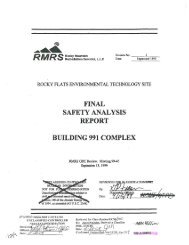silo 3 - U.S. Department of Energy
silo 3 - U.S. Department of Energy
silo 3 - U.S. Department of Energy
You also want an ePaper? Increase the reach of your titles
YUMPU automatically turns print PDFs into web optimized ePapers that Google loves.
.. 8 .<br />
t r:<br />
F' (3 :2*-<br />
Access and Retrieval Strategy for the Silo 3 Project<br />
Document No. 40430-PL-0002, Rev. 1<br />
September 2003<br />
_- _ _ ~<br />
' SILO 3 MATERIAL<br />
~ ~ _<br />
_ ~<br />
5 Q-6-9--<br />
Silo 3 contains metal oxide material generated from the operation <strong>of</strong> the former Feed<br />
Materials Production Center (FMPC), now known as the Fernald Closure Project (FCP).<br />
1.2.1 HISTORY OF GENERATION OF SILO 3 MATERIAL<br />
Raffinate streams from FMPC's solvent extraction process were dewatered using rotary<br />
vacuum filters. The filtrate streams were then processed through evaporators, and the<br />
evaporator concentrates were further processed using either a spray calciner or a rotary<br />
calciner. From plant startup through the mid-1 950s, a spray calciner processed the<br />
concentrates. Approximately 35 percent <strong>of</strong> the Silo 3 material is believed to have come<br />
from this process. Because <strong>of</strong> operational difficulties with the spray calciners, a rotary<br />
calciner process was implemented. In this process, the evaporator concentrates were<br />
transferred to a drum dryer and, finally, to a rotary calciner. The calciner removed residual<br />
liquids and converted the metal nitrates to metal oxides. The resulting fine powdered<br />
metal oxides were pneumatically transferred to Silo 3 for storage. Transfer <strong>of</strong> all materials<br />
into Silo 3 continued until 1957.<br />
1.2.2 QUANTITY AND CHARACTERISTICS OF SILO 3 MATERIAL<br />
Approximately 5,100 yd3 <strong>of</strong> metal oxide material are stored in Silo 3. The predominant<br />
radionuclide <strong>of</strong> concern is thorium-230, which is produced from the natural decay <strong>of</strong><br />
uranium-238. Silo 3 material is classified as 11 (e)(2) byproduct material under the Atomic<br />
<strong>Energy</strong> Act <strong>of</strong> 1954, as amended, and contains several Resource Conservation and<br />
Recovery Act <strong>of</strong> 1976 (RCRA) metals. Silo,3 material is specifically exempt from<br />
regulation as a hazardous waste under RCRA because <strong>of</strong> its classification as 1 1 (e)(2)<br />
byproduct material.<br />
Based on historical information and recent sampling events, the following assumptions are<br />
made regarding the physical characteristics <strong>of</strong> the Silo 3 material:<br />
0 The uppermost two-thirds <strong>of</strong> the material is dry, fine powder, similar to fly ash.<br />
0 Using data obtained during the Silo 3 Small Scale Waste Retrieval (FEMP 19981, and<br />
the Flow Properties Test Report (Jenike & Johanson 20021, the lower third <strong>of</strong> the<br />
material is assumed to be compacted such that it cannot flow freely. Small Scale<br />
Retrieval activities removed material up to 11 feet high and 4 feet into the <strong>silo</strong>.<br />
0<br />
Miscellaneous debris, such as simple hand tools, personal protective equipment (PPE),<br />
and plastic bags, are potentially present in the <strong>silo</strong>.<br />
0 About ninety percent (by weight) <strong>of</strong> the Silo 3 material sample passes through a 200-<br />
mesh sieve. This indicates that the majority <strong>of</strong> the contents are expected to be silt/clay<br />
size or smaller. Much <strong>of</strong> the Silo 3 material sample was easily fluidized, dispersible,<br />
and flowable. Recent particle size analyses (Savannah River Technology Center 2001 1<br />
showed that most <strong>of</strong> the material consists <strong>of</strong> particles greater than 1 micron. However,<br />
these particles are aggregates <strong>of</strong> submicron size particles, that can be easily dispersed<br />
during retrieval operations. It is expected that the retrieved Silo 3 material will have<br />
2<br />
000062
















